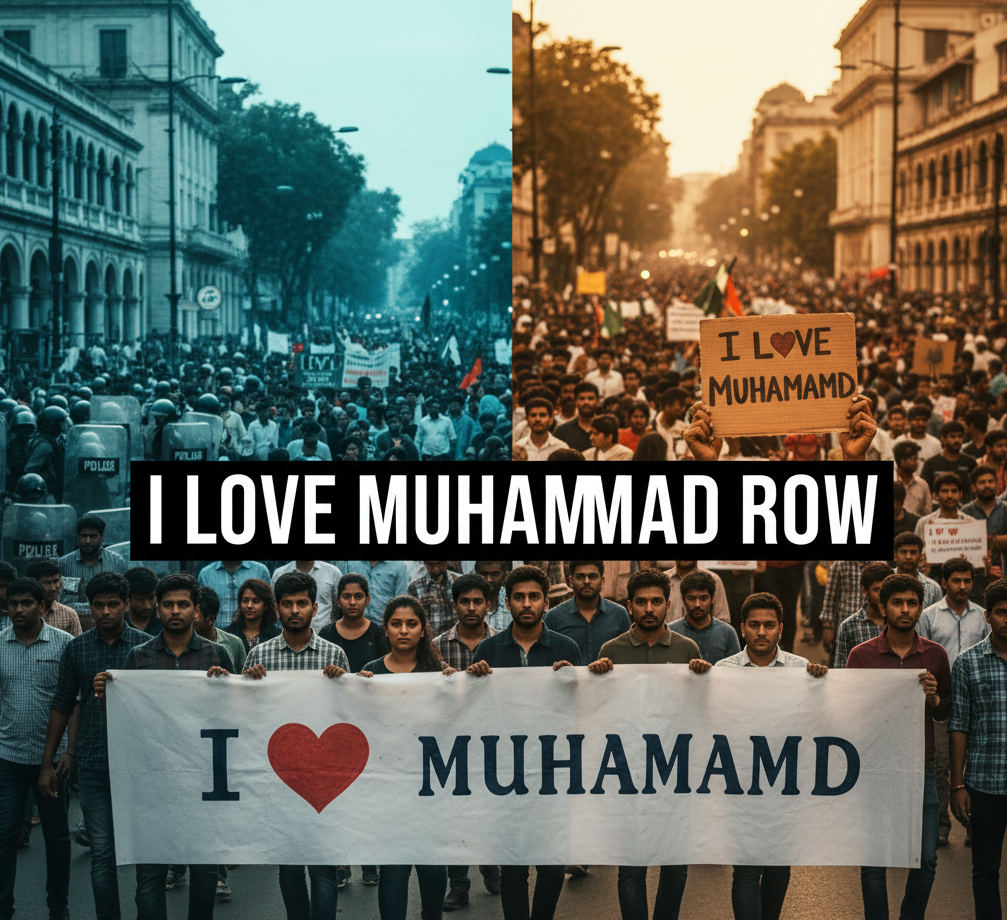
NEW DELHI – A seemingly simple expression of faith, “I Love Muhammad,” has unexpectedly become the focal point of a major controversy, triggering protests, clashes, and a fierce national debate across India. What began as a localized police action in Kanpur, Uttar Pradesh, on September 9, 2025, has since evolved into a widespread movement, highlighting the fragile nature of religious sentiment in the country.
The row’s origin can be traced back to a Barawafat (Eid-e-Milad-un-Nabi) procession held in Kanpur’s Rawatpur area. During the parade, a group of participants displayed a banner with the slogan “I Love Muhammad.” While for many, this was a heartfelt expression of love for Prophet Muhammad, local Hindu groups objected, claiming it was an unauthorized “new tradition” being introduced to a customary procession route. Police quickly intervened, leading to a heated dispute.
On September 9, the Kanpur police registered a First Information Report (FIR) against 24 individuals, including nine named and 15 unnamed, on charges of disturbing communal harmony. Police officials, including DCP Dinesh Tripathi, have clarified that the FIR was not for the slogan itself but for allegedly introducing a new practice by placing the banner in a non-traditional location and for reported instances of tearing down posters belonging to another community.
However, this official explanation has failed to quell the outrage. For a significant portion of the Muslim community, the police action is perceived as an attempt to criminalize a core tenet of their faith, the expression of devotion to the Prophet. This perception has fueled a wave of solidarity protests across the country.
From Local Dispute to a National Movement
The controversy gained traction after All India Majlis-e-Ittehadul Muslimeen (AIMIM) chief Asaduddin Owaisi spoke out on September 15. In a widely shared tweet, he challenged the police action, stating, “I LOVE MOHAMMAD. This is not a crime. And if it is, then I am ready to accept every punishment for it.” His words transformed the slogan into a symbol of defiance and a rallying cry for the protection of religious and constitutional rights.
After Owaisi’s tweet, the movement spread beyond Uttar Pradesh. Protests, both peaceful and violent, have been reported in states like Uttarakhand (Kashipur), Maharashtra (Nagpur, Mumbra), and Gujarat (Godhra.
Unnao & Bareilly: In Unnao, processions with “I Love Muhammad” banners led to clashes and stone-pelting with police, resulting in multiple FIRs. In Bareilly, local clerics supported the campaign and encouraged displaying the slogan on doors and walls, describing it as a statement of faith and peace.
Gujarat: The situation escalated in Gujarat, where reports surfaced of police allegedly parading and beating Muslim youths for sharing posts with the slogan on social media. These actions led to increased protests and legal notices from minority groups.
These incidents highlight a growing belief that expressing love for the Prophet should not result in legal action, especially when it is seen as part of one’s religious identity. Protesters argue that the right to express one’s faith peacefully is a fundamental freedom protected by the Constitution. For a detailed look into the legal aspects of such religious expressions, you can read more in our India News section.
The Digital Campaign and Community Response. The “I Love Muhammad” controversy has also turned into a significant digital movement. Social media is filled with posts, hashtags, and profile picture changes showing support. This online campaign has helped organize protests and spread the message far beyond the sites of demonstrations.
Religious scholars and community leaders have joined the discussion, defending the campaign as a natural and peaceful expression of faith. They have urged authorities to withdraw the FIRs, labeling them legally unsustainable and socially divisive.
The government and police maintain that their actions are only to keep law and order and prevent new traditions that could threaten communal harmony. They have warned against spreading misinformation and assured that they are taking action only against those who break the law. However, the conflicting narratives have created a trust gap, leaving many questioning where the line between religious expression and public order truly lies. For more on the role of social media in such events.



